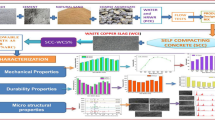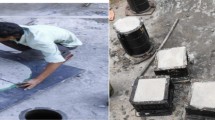Abstract
This paper aims at the experimental study of durability properties and long-term mechanical properties of self-compacting concrete with fly ash as secondary cementitious material and copper slag as inert material. Cement replaced with fly ash at 20% level and fine aggregate replaced with copper slag at 10%, 20%, 30%, 40%, 50%, 60%, 70%, 80%, 90%, and 100%. Twelve different mixes were prepared to assess the durability properties like RCPT, Sorptivity, and UPV. The microstructure of SCC was observed using a Scanning Electron Microscope (SEM). Mechanical properties like compressive, split tensile, and flexure strength at the ages of 28, 90, 180, and 365 days were evaluated. Compressive strength with CS improved from 85.53 to 102.89 MPa, Split tensile strength varies from 4.82 to 6.74 MPa, and flexural strength changes from 11.03 to 11.82 MPa at a 40% replacement level. All mechanical properties were enhanced with the use of copper slag. Copper slag improved the resistance against chloride penetration. RCPT showed optimum at a 50% CS which was reduced from 1054.74 to 401.26 coulombs. Sorptivity with 0.013 mm/s1/2 to 0.006 mm/s1/2 for 40 and 50% also. UPV varies from 4383 to 4565 m/s. 40% copper slag partial replacement enhanced the properties of self-compacting concrete, and up to 60% of fine aggregate can be substituted with industrial copper waste. By this investigation, copper slag can be used as a sustainable building material.












Similar content being viewed by others
Change history
14 February 2023
A Correction to this paper has been published: https://doi.org/10.1007/s42107-023-00606-4
References
Afshoon, I., & Sharifi, Y. (2020). Utilization of micro copper slag in SCC subjected to high temperature. J Ournal of Building Engineering. https://doi.org/10.1016/j.jobe.2019.101128I
K. S. Al-Jabri, A. H. Al-Saidy, and R. Taha,(2011) Effect of copper slag as a fine aggregate on the properties of cement mortars and concrete,Construction and Building Materials., https://doi.org/10.1016/j.conbuildmat.2010.06.090.
Almohammad-albakkar, M., & Behfarnia, K. (2021). Water penetration resistance of the self-compacting concrete by the combined addition of micro and nano-silica. Asian Journal of Civil Engineering, 22, 1–12. https://doi.org/10.1007/s42107-020-00293-5
M. A. S. Anjos, A. Camões, P. Campos, G. A. Azeredo, and R. L. S. Ferreira,(2020) Effect of high volume fly ash and metakaolin with and without hydrated lime on the properties of self-compacting concrete, Journal of Building Engineering., 27, https://doi.org/10.1016/j.jobe.2019.100985.
S. Arunchaitanya and E. Arunakanthi,(2019) Usage of mineral admixtures in self compacting concrete—A review, International Journal of Innovative Technology and Exploring Engineering., 8(3),.
K. G. Babu and G. S. Nageswara Rao,(1993) Efficiency of fly ash in concrete, Cement and concrete composites., vol. 15(4), 223–229, https://doi.org/10.1016/0958-9465(93)90025-5.
Buari, T. A., Olutoge, F. A., Ayinnuola, G. M., Okeyinka, O. M., & Adeleke, J. S. (2019). Short term durability study of groundnut shell ash blended self consolidating high performance concrete in sulphate and acid environments. Asian Journal of Civil Engineering, 20, 649–658. https://doi.org/10.1007/s42107-019-00131-3
S. Chithra, S. R. R. Senthil Kumar, and K. Chinnaraju,(2016)The effect of Colloidal Nano-silica on workability, mechanical and durability properties of High Performance Concrete with Copper slag as partial fine aggregate, Construction and Building Materials., 113, 794–804, 2016, https://doi.org/10.1016/j.conbuildmat..03.119.
R. Choudhary, R. Gupta, and R. Nagar, (2019) Impact on fresh, mechanical, and microstructural properties of high strength self-compacting concrete by marble cutting slurry waste, fly ash, and silica fume, Construction and Building Materials, 239, 117888, 2020, https://doi.org/10.1016/j.conbuildmat..117888.
Y. T. H. Cu, M. V. Tran, C. H. Ho, and P. H. Nguyen,(2020) Relationship between workability and rheological parameters of self-compacting concrete used for vertical pump up to supertall buildings, Journal of Building Engineering, 32, 101786, https://doi.org/10.1016/j.jobe.2020.101786.
V. M. C. F. Cunha, J. A. O. Barros, and J. M. Sena-Cruz,(2010) PulloutBehavior of Steel Fibers in Self-Compacting Concrete,Journal of Materials in Civil Engineering., 22(1), 1–9, https://doi.org/10.1061/(asce)mt.1943-5533.0000001.
H. A. F. Dehwah,(2012) Mechanical properties of self-compacting concrete incorporating quarry dust powder, silica fume or fly ash,Construction and Building Materials., 26(1), pp. 547–551, https://doi.org/10.1016/j.conbuildmat.2011.06.056.
P. Dinakar, M. Kartik Reddy, and M. Sharma,(2013) Behaviour of self compacting concrete using Portland pozzolana cement with different levels of fly ash, Materials and Design, 46, 609–616, https://doi.org/10.1016/j.matdes.2012.11.015.
A. R. Esquinas, J. I. Álvarez, J. R. Jiménez, and J. M. Fernández,(2018) Durability of self-compacting concrete made from non-conforming fly ash from coal-fired power plants, Construction and Building Materials., 189, 993–1006, https://doi.org/10.1016/j.conbuildmat.2018.09.056.
L. García, M. Valcuende, S. Balasch, and J. Fernández-LLebrez, (2013) Study of Robustness of Self-Compacting Concretes Made with Low Fines Content, Journal of Materials in Civil Engineering. 25(4), 497–503, https://doi.org/10.1061/(asce)mt.1943-5533.0000609.
S. Geetha and S. Madhavan (2017) High Performance Concrete with Copper slag for Marine Environment, Materials: Today Proceeding., 4(2), 3525–3533, https://doi.org/10.1016/j.matpr.2017.02.243.
N. Gupta, Rafat Siddique (2020) Durability characteristics of self-compacting concrete made with copper slag. Construction and Building Materials., 247, https://doi.org/10.1016/j.conbuildmat.2020.118580
Guru Jawahar, J., Yakshareddy, B., Sashidhar, C., Sreenivasulu, C., & Ramana Reddy, I. V. (2018). Evolution of 112-day drying shrinkage equation of fly ash blended self-compacting concrete. Asian Journal of Civil Engineering, 19, 703–712. https://doi.org/10.1007/s42107-018-0054-z
K. Ishimaru, H. Mizuguchi, C. Hashimoto, T. Ueda, K. Fujita, and M. Ohmi,(2005) Properties of concrete using copper slag and second class fly ash as a part of fine aggregate, Zair. Journal-Society of Materials Science Japan, 54(8), 828–833, Aug. 2005, https://doi.org/10.2472/jsms.54.828.
M. Jalal, A. Pouladkhan, O. F. Harandi, and D. Jafari,(2015) Comparative study on effects of Class F fly ash, nano silica and silica fume on properties of high performance self compacting concrete, Construction and Building Materials., https://doi.org/10.1016/j.conbuildmat.2015.07.001.
Kandasamy, S., & Kothandaraman, S. (2020). The effect of formwork liner on the service life of self-compacting concrete. Asian Journal of Civil Engineering, 21, 1239–1247. https://doi.org/10.1007/s42107-020-00272-w
V. Kannan and K. Ganesan,(2016) Effect of Tricalcium Aluminate on Durability Properties of Self-Compacting Concrete Incorporating Rice Husk Ash and Metakaolin, Journal of Materials in Civil Engineering., 28(1), p 04015063, https://doi.org/10.1061/(asce)mt.1943-5533.0001330.
A. R. Lori, A. Hassani, and R. Sedghi,(2019)Investigating the mechanical and hydraulic characteristics of pervious concrete containing copper slag as coarse aggregate, Construction and Building Materials., 197, 130–142, https://doi.org/10.1016/j.conbuildmat.2018.11.230.
Mithun, B. M., & Narasimhan, M. C. (2015). Performance of alkali activated slag concrete mixes incorporating copper slag as fine aggregate. Journal of Cleaner Production. https://doi.org/10.1016/j.jclepro.2015.06.026
B. H. Nagaratnam, M. A. Mannan, M. E. Rahman, A. K. Mirasa,(2019) A. Richardson, and O. Nabinejad, Strength and microstructural characteristics of palm oil fuel ash and fly ash as binary and ternary blends in Self-Compacting concrete, Construction and Building Materials., 202, 103–120, https://doi.org/10.1016/j.conbuildmat.2018.12.139.
A. Nainwal, P. K. Emani, M. C. Shah, A. Negi, V. Kumar, and P. Negi,(2021) The influence of Metakaolin on the copper slag substituted concrete with the fine aggregate of Beas river, Materials Today:Proceedings., no. xxxx, https://doi.org/10.1016/j.matpr.2020.12.981.
A. S. Reddy, P. R. Kumar, and P. A. Raj,(2020) Development of Sustainable Performance Index (SPI) for Self-Compacting Concretes,Journal of Building Engineering, 27, 100974, https://doi.org/10.1016/j.jobe.2019.100974.
G.M. Sadiqul Islam, Muhammad Tanveer Raihan, Md. Mehedi hasan, Md. Rashadin (2019) Effect of retarding superplasticizers on the properties of cement paste, mortar and concrete. Asian Journal of Civil Engineering, 20, 591-601, https://doi.org/10.1007/s42107-019-00128-y
A. K. Saha,(2018) Effect of class F fly ash on the durability properties of concrete, Sustainable Environment Research., 28(1),. 25–31, https://doi.org/10.1016/j.serj.2017.09.001.
Sharifi, Y., Afshoon, I., MortezaNematollahzade, M. G., & Momeni, M.-A. (2020). Effect of copper slag on the resistance characteristics of SCC exposed to the acidic environment. Asian Journal of Civil Engineering, 21, 597–609. https://doi.org/10.1007/s42107-019-00218-x
R. Sharma, Riwaz A. khan (2020) Carbonation Resistance of Self-Compacting Concrete Incorporating Copper slag as Fine aggregate, American Society of Civil Engineering, 32, https://doi.org/10.1061/(ASCE)MT.1943-5533.0003200
Sharma, R., & Khan, R. A. (2017). Durability assessment of self compacting concrete incorporating copper slag as fine aggregate. Construction and Building Materials., 155, 617–629. https://doi.org/10.1016/j.conbuildmat.2017.08.074
R. Siddique, Properties of self-compacting concrete containing class F fly ash, Materials and Design., 32(3), pp. 1501–1507, 2011, https://doi.org/10.1016/j.matdes.2010.08.043.
M. Soleymani Ashtiani, A. N. Scott, and R. P. Dhakal (2013) Mechanical and fresh properties of high-strength self-compacting concrete containing class C fly ash, Construction and Building Materials., 47, 1217–1224, 2013, https://doi.org/10.1016/j.conbuildmat..06.015.
Sandip Sonule, K.C.tayade, N.V.P.Vidyasagar, Avani Bhushan gupta (2021) A case study on performance of self-compacting concrete in highly congested reinforcement of cast in situ structure. Asian Journal of Civil Engineering, 22, 1423-1432, https://doi.org/10.1007/s42107-021-00378-9
G. Sua-iam and N. Makul (2017) Incorporation of high-volume fly ash waste and high-volume recycled alumina waste in the production of self-consolidating concrete, Journal of clean Production., https://doi.org/10.1016/j.jclepro.2017.05.075.
M. D. A. Thomas,(2007) Optimising the Use of Fly Ash in Concrete, Portland Cement Association., 24,.
M. Toledano-Prados, M. Lorenzo-Pesqueira, B. González-Fonteboa, and S. Seara-Paz,(2013) Effect of polycarboxylate superplasticisers on large amounts of fly ash cements, Construction and Building Materials., 48, 628–635, https://doi.org/10.1016/j.conbuildmat.2013.07.069.
Z. T. Yao et al. (2014) A comprehensive review on the applications of coal fly ash, Earth-Science Reviews. 2015, https://doi.org/10.1016/j.earscirev.11.016.
Funding
None. No funding to declare.
Author information
Authors and Affiliations
Contributions
Experimental design, implementation, results analysis, and manuscript writing were done by Mr. SA. Project supervision and results evaluation was carried out by Dr. EA. Final manuscript was approved by all the authors.
Corresponding author
Ethics declarations
Competing interests
The authors declare no competing interests.
Conflict of interest
No conflict of interest to declare.
Additional information
Publisher's Note
Springer Nature remains neutral with regard to jurisdictional claims in published maps and institutional affiliations.
The original online version of this article was revised: there was an error in the second paragraph under the section Materials and mix design.
Rights and permissions
Springer Nature or its licensor (e.g. a society or other partner) holds exclusive rights to this article under a publishing agreement with the author(s) or other rightsholder(s); author self-archiving of the accepted manuscript version of this article is solely governed by the terms of such publishing agreement and applicable law.
About this article
Cite this article
Sambangi, A., Eluru, A. Role of copper slag on improvement of strength, quality and durability of high-strength self-compacting concrete: an industrial waste. Asian J Civ Eng 23, 961–971 (2022). https://doi.org/10.1007/s42107-022-00466-4
Received:
Accepted:
Published:
Issue Date:
DOI: https://doi.org/10.1007/s42107-022-00466-4




